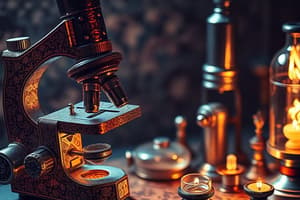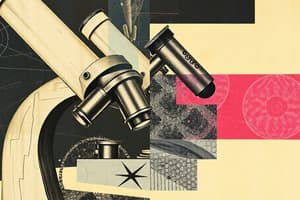Podcast
Questions and Answers
Which feature allows a microscope to remain in focus when objectives change?
Which feature allows a microscope to remain in focus when objectives change?
- Parcentral
- Working distance
- Interpupillary distance
- Parfocal (correct)
What is the primary function of the iris diaphragm in a microscope?
What is the primary function of the iris diaphragm in a microscope?
- To hold the slide in place
- To increase the magnification
- To adjust the interpupillary distance
- To control the brightness of the illumination (correct)
Which type of microscope uses an oil immersion objective to achieve higher magnification?
Which type of microscope uses an oil immersion objective to achieve higher magnification?
- Transmission Electron Microscope
- Dissecting Microscope
- Compound Light Microscope (correct)
- Scanning Electron Microscope
What is typically adjusted using the coarse adjustment knob on a microscope?
What is typically adjusted using the coarse adjustment knob on a microscope?
Which characteristic of a microscope is defined by the ratio of its magnification to the numerical aperture?
Which characteristic of a microscope is defined by the ratio of its magnification to the numerical aperture?
Which of the following is a feature of the compound light microscope?
Which of the following is a feature of the compound light microscope?
What is the purpose of the rheostat in a microscope?
What is the purpose of the rheostat in a microscope?
In a microscope, what does the term 'parfocal' refer to?
In a microscope, what does the term 'parfocal' refer to?
Which part of the microscope adjusts the amount of light reaching the specimen?
Which part of the microscope adjusts the amount of light reaching the specimen?
How does a scanning electron microscope (SEM) differ from a transmission electron microscope (TEM)?
How does a scanning electron microscope (SEM) differ from a transmission electron microscope (TEM)?
What is typically true about the working distance in a microscope?
What is typically true about the working distance in a microscope?
In the context of microscopy, what does 'field of view' refer to?
In the context of microscopy, what does 'field of view' refer to?
Flashcards are hidden until you start studying
Study Notes
Compound Light Microscope
- A type of light microscope used to view small objects or sections of objects that are too small to be seen with the naked eye.
Dissecting Microscope
- A type of microscope used to view larger objects or organisms that cannot be viewed with a compound light microscope.
Transmission Electron Microscope (TEM)
- A type of microscope that uses an electron beam to view the internal structure of objects.
Scanning Electron Microscope (SEM)
- A type of microscope that uses an electron beam to view the surface of objects.
Microscope Components
- Arm supports the microscope.
- Illuminator provides light for viewing.
- Base provides stability.
- Rheostat controls the brightness of illumination.
- Ocular is the eyepiece through which the user sees the specimen.
- Objectives are lenses that magnify the specimen.
- Nosepiece holds the objectives and allows them to be rotated.
- Mechanical stage moves the specimen so that it can be viewed from different angles.
- Stage supports the specimen.
- Course adjustment knob raises and lowers the stage in large increments.
- Fine adjustment knob raises and lowers the stage in small increments.
- Condenser lens focuses the light onto the specimen.
- Filter holder holds filters that can be used to adjust the color of the light.
- Control knobs for condenser adjust the position of the condenser.
- Control knobs for stage move the stage horizontally and vertically.
- Lever for Iris Diaphragm adjusts the amount of light passing through the specimen.
- Iris Diaphragm controls the diameter of the light beam.
Objectives
- Scanning (4X): provides a wide view of the specimen.
- Medium power (10X).
- High power (40X).
- Oil immersion (100X): requires immersion oil to be placed between the objective lens and the specimen.
Microscope Properties
- Magnification: the extent to which the image is enlarged.
- Numerical aperture (NA): a measure of the light-gathering ability of the lens.
- Mechanical tube length: the distance between the objective lens and the ocular lens.
- Coverslip thickness: the thickness of the coverslip used to cover the specimen.
Viewing Properties
- Field of view: the area of the specimen that is visible through the ocular lens.
- Parfocal: the objectives are aligned so that the specimen remains in focus when the objective is changed.
- Parcentral: the center of the field of view remains the same when the objective is changed.
Other Properties
- Working distance: the distance between the objective lens and the specimen when the specimen is in focus.
Virtual Microscopes
- Virtual microscopes are computer simulations of real microscopes allowing users to explore virtual specimens.
Compound Light Microscope
-
A compound light microscope uses a series of lenses to magnify an object.
-
The lenses are arranged in a tube, which is attached to a base that supports the microscope.
Dissecting Microscope
-
A dissecting microscope is used to view large objects, such as insects or plants.
-
The dissecting microscope has two lenses, one for each eye.
-
The lenses are positioned so that the image appears three-dimensional.
Transmission Electron Microscope (TEM)
-
A transmission electron microscope is used to view very small objects, such as viruses or bacteria.
-
TEMs use a beam of electrons to create an image.
-
The image is projected onto a screen.
Scanning Electron Microscope (SEM)
-
A scanning electron microscope is used to view the surface of an object.
-
SEMs use a beam of electrons to scan the surface of an object.
-
The electrons that are scattered from the surface are then detected and used to create an image.
Microscope Parts
-
The base of a microscope supports the microscope.
-
The arm connects the base to the body of the microscope.
-
The stage is a platform where the specimen is placed.
-
The objective lens is a lens that magnifies the specimen.
-
The ocular lens is a lens that magnifies the image produced by the objective lens.
-
The condenser lens focuses light on the specimen.
-
The iris diaphragm controls the amount of light that passes through the specimen.
Microscope Functions
-
Magnification is the ability to enlarge the image of an object.
-
Resolution is the ability to distinguish between two closely spaced objects.
-
Numerical aperture (NA) is a measure of the ability of a lens to gather light. The higher the NA, the better the resolution.
-
Working distance is the distance between the objective lens and the specimen.
-
Field of view is the area that can be seen through the microscope.
-
Parfocal means that the microscope remains in focus when the objective lens is changed.
-
Parcentral means that the center of the field of view remains the same when the objective lens is changed.
Objectives
-
Scanning objective (4X) provides a low magnification with a wide field of view.
-
Low-power objective (10X) provides a medium magnification with a narrower field of view than the scanning objective.
-
High-power objective (40X) provides a high magnification with a even narrower field of view than the low-power objective.
-
Oil-immersion objective (100X) is used to view very small objects with the highest magnification, the objective is immersed in oil so that light passes more directly through the specimen resulting in a clearer image.
Studying That Suits You
Use AI to generate personalized quizzes and flashcards to suit your learning preferences.




